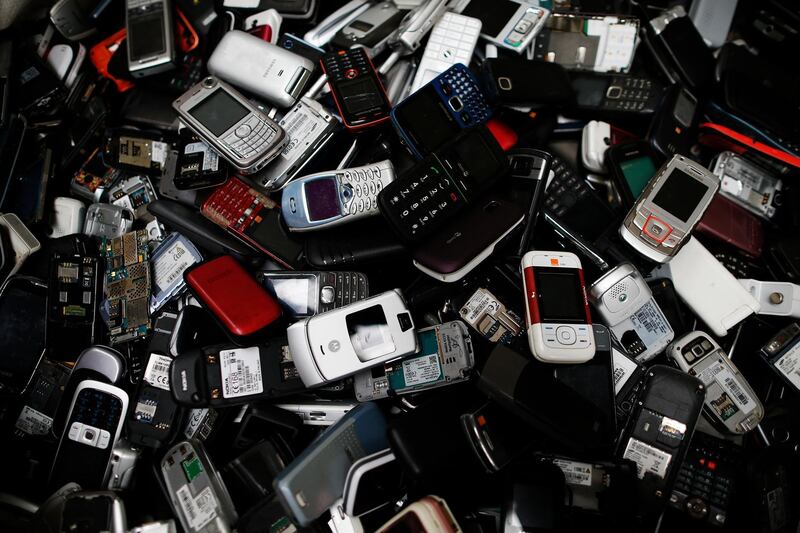This month, the UN released a report on the growing problem of electronic waste – the gadgets and devices that you throw away each time you upgrade or buy new.
With a record 53 million tonnes generated globally last year, this is now the fastest growing category of global waste, and the issue is particularly pressing in the UAE. Since 2016, according to the Global E-waste Monitor, the amount of e-waste in the Emirates has risen by 28,000 tonnes a year. As of 2019, on average, every person in the UAE accounts for 15kg worth of annual e-waste. The global average is 7.3kg.
However, the menace of e-waste is largely hidden, partly because the sleek design of gadgets belies the toxicity of the chemicals within them. As they break down, lead, mercury, cadmium and other heavy metals pollute the environment and pose a danger to people in the vicinity. The toll on the planet is huge, but the problem is barely on consumers’ radar.
“Electronics are proliferating,” says Jim Puckett of Basel Action Network, a campaign group in Seattle. “We have ever-smaller bits of circuitry floating around, and if every product becomes electronic, every product becomes electronic waste.”
With higher disposable incomes, the lure of the upgrade and new 5G services all set to drive sales, the UN report predicts a global surge to 75 million tonnes of e-waste annually by 2030.
A record 53.6 million tonnes (Mt) of e-waste was produced globally in 2019 — the weight of 350 cruise ships the size of the Queen Mary 2.
— UN Environment Programme (@UNEP) July 2, 2020
More from the UN’s Global E-waste Monitor 2020: https://t.co/ONahmW3ejT #BeatPollution pic.twitter.com/oZQkPcoP6C
In high-income countries, we’re used to the idea of waste being taken away and made to disappear. We rarely consider what happens to it, and, according to Puckett, the e-waste story is not one people want to hear.
“For 20 years we've been trying to tell people that ‘away’ is actually a place,” he says. “So when you throw something ‘away’ it goes somewhere, a place where people live and die.”
What happens to it all? Less than 20 per cent of e-waste is said to be recycled, but the definition of what constitutes “recycled” is vague. The Recycling Hub in Dubai’s Industrial City is held up as a role model for how things should be done, processing as much as 39,000 tonnes of e-waste from across the Middle East, Africa and the Caucasus every year. Many nations, however, offload the problem by marking it as recycled and shipping it to the global south.
China used to accept the bulk of it, but having stopped in 2017, Africa and Southeast Asia are the new dumping grounds. Without regulations to govern its disposal, toxins pollute the air, soil and water, with a knock-on impact on human health. “It's heartbreaking to watch documentaries about children in Pakistan, Burkina Faso and young men in Ghana, inhaling hazardous chemicals as they remove precious metals for a pittance,” says Sabeena Ahmed of Dubai’s The Little Fair Trade Shop. “Consumers and governments must act and hold electronics manufacturers accountable.”
Ahmed uses and swears by the Fairphone, an ethically-produced, sustainable smartphone that’s easy to repair and is designed to last five years – much longer than most devices. Teracube, a new smartphone that recently hit its target on crowd-funding platform Kickstarter, is another example of a gadget putting ethics first.

But bigger firms pay less heed to such concerns, according to Puckett. “They don't necessarily want their products to last a long time, because they don't get rewarded for it,” he says.
So-called “right to repair” laws are being considered in a number of countries in order to reduce disposability and enforce longer product life, but these plans are being fought by manufacturers.
Last week, rumours surfaced that Apple was considering omitting the headphones and charger from the iPhone 12, due to ship later this year. That would have a small positive impact on e-waste, but the online reaction demonstrated that many consumers felt cheated out of items they believe to be rightfully theirs. While Puckett acknowledges that the primary responsibility for e-waste lies with manufacturers, he believes that only a radical rethinking of the way we consume electronics can make the problem disappear.
“We have get away from societies where everybody has to own every little thing,” he says. “Instead, we need manufacturers to offer subscriber services, so it’s in their interest to make equipment last as long as possible.”
Ahmed agrees. “We must work collectively to change the shopping habits and mindsets of individuals,” she says. “I am optimistic that there is a growing movement of compassionate ethical consumers in the UAE who are questioning how and where e-waste is recycled.”
Five ways we can combat e-waste
1. Buy fewer electronics
Is the gadget really necessary? Could you do without? Do you already have a gadget that could fulfil its function? And if you do have to buy, what’s the most environmentally-friendly option?
2. Extend the life of gadgets by taking better care of them
Use them until they're genuinely non-functioning, rather than merely old-fashioned.
3. Find an alternative use for old gadgets
Smartphones have many uses – remote controls, GPS units and so on. Children can use old tablets for entertainment. And don't take a hammer to a hard drive to destroy data. Erase it securely, then reuse it.
4. If you have to get rid of a gadget, make use of buyback programmes offered by some manufacturers
Alternatively, resell, give away or donate to charity. Anything but landfill.
5. Read up about it
Educate yourself and others about the perils of e-waste, its hidden toxicity, and how removing an electronic device from the home doesn’t remove it from the world.






